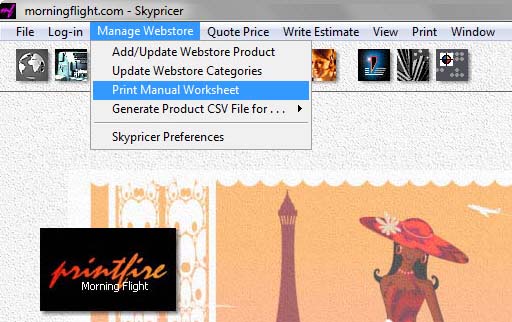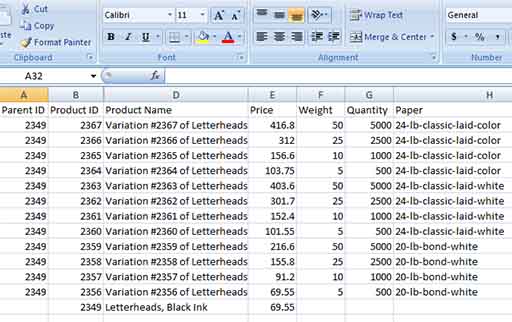The Skypricer
Patent Pending
Snapshot
In the e-Commerce world, all printed products are products with variations. At a minimum, you're dealing with different quantities. To sell printed products online you have to first calculate the price of each variation, then individually upload them all, one at a time, into shopping cart software.
What it does
The Skypricer does a number of things but will do two of them really well: Calculate the price of each variation, then either print a worksheet to speed up manual entry of online products, or create a CSV text file for uploading all variations directly into a number of different shopping carts.
Among other Things
Online sellers currently have two options for adding or updating products: Keyboard entry of each product and its variations directly into shopping cart software, or uploading from a file. Because such files are vendor-specific, neither option allows for transferring a store from one vendor to another.
The Invention
The Skypricer maintains an independent database that controls the price and makeup of online products. In addition to automating the pricing process, the invention enables sellers to migrate their store in bulk to a competing vendor when more desirable shopping cart software becomes available.
During the past decade, the growth of e-Commerce has been such that even small mom and pop stores can now afford to sell goods online. Many are in fact compelled to do so to survive.
There is a wide variety of shopping cart software available at reasonable cost, free in some cases, so it’s easy to set up an empty online store with the aid of templates. A much more challenging and labor-intensive task is filling the virtual online shelves with products.
Online sellers have two options, both mutually exclusive: They can enter product prices and descriptions directly into shopping cart software via keyboard, one product at a time, or enter them into so-called import files and upload all their online products into shopping cart software in bulk.
The first option is viable only if the seller’s goods are limited to a small number of simple products with few or no variations. Selecting this option pre-empts the second option because a general file import will overwrite any changes previously made by direct entry.
The second option is suitable for large quantities of both simple and complex products and tends to be more efficient. But it, too, has drawbacks. Import files are generally CSV, XML, or Excel text files that often contain tens of thousands of lines of text. Every line must still be entered manually, via keyboard, in the precise format prescribed by the shopping cart vendor. A single missing comma will unceremoniously terminate the import.
The second option brings with it a further disadvantage in that vendors of shopping cart software typically develop their own data structures and techniques for assembling and importing listing prices. That makes transferring a seller’s hundreds, and often thousands, of products into alternate shopping cart software a herculean task. A reasonable observer might conclude that this lack of conformity among the import structures adopted by competing vendors is not accidental.
Both options suffer from excessive keyboard input. Complex products in particular involve an inordinate amount of arithmetic done on a calculator. For example, a simple T-Shirt offered in four sizes and five colors results in twenty separate configurations. A letterhead offered in ten quantities on four different types of paper, folded and unfolded, results in no less than eighty items that all need to be individually priced and entered. Few activities in e-Commerce are in greater need of having a computer do the arithmetic.
now available at the Morning Flight Shop





